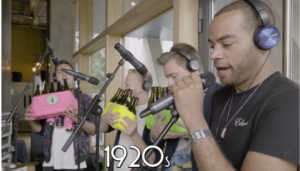The term crystal is often used to refer to glassware that has a more elegant form. However, that is not the official difference between these two materials. So, what type of glass is crystal? Can it be recycled? And how are they different?
How is crystal different from glass?
Glass
Glass is an inert and natural material, made from raw materials that are abundant in nature and sustainably sourced, such as sand, soda ash and limestone. Combined with recycled glass, these substances are then heated in a furnace into a liquid state that can be molded into a desired shape.
Other minerals like silica and barium can be added to manipulate the color, durability, and thickness to create different types – such as crystal.
Crystal
Unlike the name suggests, crystal glass doesn’t contain a crystalline structure. The name stems from the Italian word “Cristallo”, which was used for high-end hand-blown glass in Murano, Italy.
This means it’s a subcategory of glass packaging or glassware, made in the same way, but with different components. That’s the reason why all crystal is glass, but not all glass is crystal.
It contains strengthening minerals like lead-oxide, potassium carbonate or barium oxide to make the material more durable. The added strength allows the crystal to be molded into thin, delicate shapes, which we often associate with sophisticated craftmanship and elegance.
Glass vs. crystal: which is better?
Recyclability
Glass itself is sustainable, inert, and 100% recyclable, reusable and refillable. It can be recycled endlessly without losing any of its quality or purity.
Recycled glass, also called cullet, is the most important ingredient in glass manufacturing. The benefit of using cullet to produce new jars and bottles is that it uses 40% less energy than virgin materials to be melted and shaped. By increasing the amount of cullet that goes into production through industry projects like Close the Glass Loop, we’re conserving natural resources and energy – every 10% increase in cullet, leads to a 3% reduction in energy consumption. That’s why it‘s so important to make that little trip to the bottle bank each week to recycle our jars, bottles and containers.
Crystal on the other hand is one of the types of glass that cannot be recycled. As it is made with added materials, such as barium, potassium and zinc oxide, it can’t be recycled together with jars and bottles.
Strength
Because crystal is made with added minerals, the material is stronger and more durable. This is different from glass stemware, which needs a certain thickness not to break.
Of course, crystal should be handled with care, but your collection of wine glasses will never lose their shiny personality, and they’ll hardly ever scratch.
Elegance and design
Compared to crystal, glass is a cheaper option. This is because it requires less materials to be produced, making it more affordable for consumers.
However, part of the reason crystal is more expensive than glass, is also because it is perceived as more elegant and sophisticated. Its added ingredients make it slightly porous, giving it the ability to refract light.
It can also be crafted into a wide range of different designs. Unlike glass, crystal is soft enough to add smooth hand-cut details to its surface without compromising its durability or structure. The material can be molded and shaped more easily than glass, allowing the artist to add different intricate patterns.
What are crystal and glass used for?
Glass is one of the most stable packaging materials. Thanks to its inertness, there is no risk of harmful chemicals coming into contact with food or drinks. This makes it a safe option for long-term storage and protection of food and beverages.
Crystal, in comparison, contains additional elements, namely lead oxide. Due to the possible contamination from lead oxide into your food or beverages, it’s often advised not to use this for food storage. However, under normal consumption conditions, no hazardous lead is released, making it safe to use.
The increasing concerns of lead crystal have led to the development of “lead-free crystal glass.” To make crystal safer for food storage, the only difference is that the lead oxide in the production is replaced with barium oxide, zinc oxide, or potassium oxide.
How can you tell the difference between glass and crystal?
The main difference is that crystal contains anywhere from 2–30% minerals (lead or lead-free), making it possible to produce durable but thin glasses.
It is also more transparent, brighter and thinner, making it a desirable choice for high-end glassware and decorations. Its refracting properties are like a prism, decomposing the light coming through in the form of a rainbow.
Regular glass is often a little bit foggy in appearance and can typically feature a tint based on the ingredients in its composition. It can have a green tint if made with iron or a blue tint if made with soda lime. It’s also typically lighter in weight in comparison to crystal pieces of the same design.
Lastly, the most famous difference is the sound. Glass provides a dull, short, and subtle chime when tapped or flicked with your finger. When tapping crystal you hear a satisfying bell-like ringing sound, as different added materials allow the sounds to be slightly prolonged.
So, now that you know all the differences between glass and crystal and how to spot them, you can make more informed decisions when choosing the right products to buy.
Do you want to know more about the different types of glass and how to recycle them? Find here our guide on how glass recycling works.







